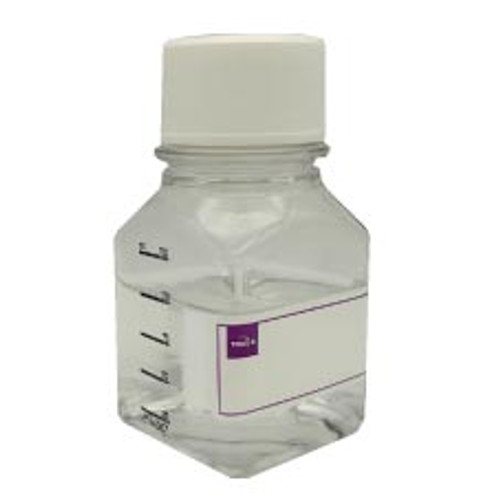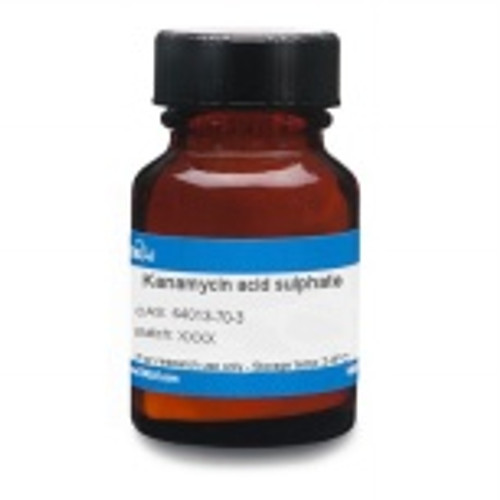Kanamycin Acid Sulfate ReadyMadeTM solution is provided as a sterile-filtered solution of Kanamycin Acid Sulfate that has been dissolved in water at a concentration of 50 mg/ml. It has been filter-sterilized using a 0.22 μm filter.
Kanamycin Acid sulfate is an aminoglycoside antibiotic that has been optimized for bioprocessing applications including biofuel production. The product is commonly used as a selective agent to select for resistant mammalian, fungal, or bacterial cells that contain the kanMX marker or other kanamycin resistance genes. Kanamycin Acid Sulfate is a form of Kanamycin Sulfate that is prepared by adding sulfuric acid to a solution of Kanamycin Acid and drying by a suitable method.
We also offer:
| Mechanism of Action |
|
| Spectrum | Kanamycin is a broad spectrum and inhibits growth of Gram-positive bacteria, Gram-negative bacteria and mycoplasmas. |
| Microbiology Applications |
Kanamycin Acid Sulfate is commonly used as a selective agent to select for resistant mammalian, fungal, or bacterial cells that contain the kanMX marker or other Kanamycin resistance genes. Kanamycin Acid sulfate is typically used at a concentration of 50 µg/mL. Kanamycin can be used as a selective agent in several types of isolation media: Kanamycin Aesculin Azide Agar - Enterococci isolation in food Perfringens Agar - SFP and TSC selective supplements for the isolation of Clostridium perfringens Kanamycin Sulfate is commonly used for in vitro microbiological antimicrobial susceptibility tests (panels, discs, and MIC strips) against Gram-positive and Gram-negative microbial isolates. Medical microbiologists use AST results to recommend antibiotic treatment options. For additional MIC data for Kanamycin Sulfate, visit our Antimicrobial Index. Kanamycin is one of the most widely used antibiotics yet its biosynthetic pathway remains unclear. Authors reconstructed the entire biosynthetic pathway through the expression of putative biosynthetic genes from S. kanamyceticus in the non-aminoglycoside-producing Streptomyces venezuelae, demonstrating the potential of pathway engineering to direct in vivo production of more robust aminoglycosides (Park et al, 2011). Bacterial fermentations using a microbioreactor with a volume of microliters is made of poly (dimethylsiloxane) and glass. Bacterial fermentations are compared to results in a 500-ml bench-scale bioreactor and the behavior is similar, thus it can be used to model different physiological states for bioprocessing using Kanamycin selection (Zanzotto et al, 2004). Consolidated bioprocessing (CBP) of lignocellulosics by Fusarium oxysporum was studied for bioethanol productivity using Agrobacterium tumefaciens transformation using a Kanamycin selection system. Engineered transformants produced approximately 60% more ethanol compared to wild-type (Anasontzis et al, 2011). |
| Plant Biology Applications |
Kanamycin is often used in the Agrobacterium-mediated transformation using the neomycin phosphotransferase gene (npt II gene) as a selection marker which confers resistance to Kanamycin (and G418). Gene transfer to cereal cells (Triticum monococcum) mediated by protoplast transformation with naked DNA. Plasmid contained a gene of interest along with the NTP II gene, and transformed were selected in medium containing Kanamycin (Lorz et al 1985). In a study of drought and salt tolerance, soybeans (DT84 cultivar) were genetically modified using Agrobacterium-mediated transformation to insert the GmDREB6 gene along with the nptII gene to select for plants resistant to Kanamycin. GmDREB6 is a dehydration-responsive element binding proteins (DREBs), a plant transcription factor that binds to specific region of promoter to activate expression of mechanisms to cope with cellular dehydration. Overexpression of GmDREB6 increased transcription levels of GmP5CS gene, which caused a higher intracellular proline content in plants growing under salt stress (Nguyen et al, 2019). |
| Eukaryotic Cell Culture Applications |
Kanamycin Sulfate was used in an in vitro model system of Henle intestinal epithelial cell infection (Henle 407 cell line) by Shigella flexneri. Bactericidal levels of Kanamycin ablated infectivity of Shigella (Hale and Bonventre, 1979). |
| Cancer Applications |
Kanamycin was used in an experimental mouse model of colorectal cancer. Following short-term induction of colitis by an irritant (dextran sulfate sodium), colon cancer cells (colon 26) were instilled intrarectally. The result was that tumors formed at the luminal mucosal surface. This model is useful to examine chemotherapeutic agents that may suppress the growth of colorectal cancer (Takahashi et al, 2004). |
| Molecular Formula | C18H36N4O11 · 2 H2SO4 |
| References |
Pryjma, et al. used Kanamycin Sulfate (TOKU-E) to select for transformed Kanamycin resistant Campylobacter jejuni cells in: FdhTU-modulated formate dehydrogenase expression and electron donor availability enhance recovery of Campylobacter jejuni following host cell infection. Link. Aragão FJL and Brasileiro ACM (2009) Positive, negative and marker-free strategies for transgenic plant selection. Braz. J. Plant Physiol. 14(1):1-10 Davis BD (1987) Mechanism of bactericidal action of Aminoglycosides. Microbiol. Rev. 51(3):341-350 Grant CCR, Konkel ME, Cieplak Jr W, and Tompkins LS (1993) Role of flagella in adherence, internalization, and translocation of Campylobacter jejuni in nonpolarized and polarized epithelial cell cultures. Infect. and Immun. 61(5):1764-1771 Lipscomb GL et al (2016) A highly thermostable Kanamycin resistance marker expands the tool kit for genetic manipulation of Caldicellulosiruptor bescii. Appl. Environ. Microbiol. 82 (14): 4421-4428 Lorz H, Baker B and Schell J (1985) Gene transfer to cereal cells mediated by protoplast transformation. Molec. And Gen. Genetics 199:178-182 Lynd LR, van Zyl WH, McBride JE and Laser M (2005) Consolidated bioprocessing of cellulosic biomass: An update. Curr. Opin. Biotechnol. 16(5):577-583 Nguyen QH et al (2019) Overexpression of the GmDREB6 gene enhances proline accumulatin and salt tolerance in genetically modified soybean plants. Sci Rep. 9:19663 PMID 31873128 Park JW et al (2011) Discovery of parallel pathways of Kanamycin biosynthesis allows antibiotic manipulation. Nat. Chem. Biol. 7(11):843-852 PMID 21983602 Takahashi T, Morotomi Ma nd Nomoto K (2004) A novel mouse model of rectal cancer established by orthotopic implantation of colon cancer cells. Cancer Sci. 95(6):514-519 PMID 15182433 Zanzotto A et al (2004) Membrane-aerated microbioreactor for high-throughput bioprocessing. Biotechnol. Bioeng. 87(2):243-254 |








